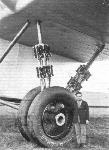Caproni Са 90
Когда в 1929 году появился 6-моторный тяжелый бомбардировщик Caproni Са 90, он стал самым большим самолетом в мире. Хотя рекорд по размаху крыла и массе в том же году побила летающая лодка Dornier Do X, крупнейшим "сухопутным" самолетом оставался Са 90 - пока в 1934 году не появился советский АНТ-20 "Максим Горький". Caproni Са 90 был построен по схеме "перевернутого" полутораплана, на его нижнем крыле устанавливались две пары тандемно расположенных W-образных двигателей Isotta-Fraschini Asso. Еще одна пара двигателей находилась на стойках над фюзеляжем.
После испытаний отдельных элементов начали программу испытаний и оценки Са 90, включавшую серию полетов, при этом были установлены рекорды высоты, длительности полета и подъема полезной нагрузки.
ТАКТИКО-ТЕХНИЧЕСКИЕ ХАРАКТЕРИСТИКИ
Caproni Са 90
Тип: тяжелый бомбардировщик
Силовая установка: шесть W-образных двигателей Isotta-Fraschini Asso каждый мощностью 1000 л. с. (746 кВт)
Летные характеристики: максимальная скорость 205 км/ч; практический потолок 4500 м; длительность пребывания в воздухе 7 ч
Масса: пустого 15 000 кг; максимальная взлетная 30 000 кг
Размеры: размах крыла 46,60 м; длина 26,95 м; высота 10,80 м; площадь крыльев 496,60 м2
Вооружение: несколько наводимых 7,7-мм пулеметов, плюс до 8000 кг бомб
Показать полностьюShow all
Flight, January 1931
THE CAPRONI 90 P. B.
Italy's Giant Bomber
DURING the last few years Sig. Caproni, who appears to revel in what are popularly known as "giant" aircraft, economised somewhat in the dimensions of his machines - even descending from the "hundreds" to the mean proportions of the light 'plane, as in the Ca.100T, or Italian version of the "Moth." Just recently, however, this well-known Italian designer reverted to his original and early belief in the large-sized machine, and produced the Caproni 90 P.B., a few particulars of which, together with illustrations, we are able to publish this week.
The Caproni 90 P.B. is a multi-engined biplane designed for military purposes, and following typical Caproni practice - short-span upper plane and low boat-like fuselage. It has a total span of 162 ft. 6 in. (49-56 m.), and an overall height of 39 ft. 4 in. (12 m.). Owing to the fine proportions of this machine it is difficult to form an idea of its real size unless compared with some adjacent object, such as buildings or men. This will be apparent on examining the accompanying illustrations.
The Ca.90 is constructed entirely of high-tension steel tubing, Sig. Caproni having decided that this material was preferable to light alloys (duralumin or aluminium). All joints and fittings for the steel tubing are of the socket type, and are turned entirely out of the solid. The entire structure has been carefully checked and tested for strength at the well-known laboratory of the Milan Royal Polytechnical College, and further tests were carried out in the testing laboratory adjacent to the Taliedo Works of the Caproni Co.
At the moment we have not got complete constructional details of this machine, but many of the general features may be disclosed by a careful study of the accompanying illustrations. It will be seen that the wings are of fairly thick section, the lower, and larger span, plane being mounted on the top of the fuselage and comprising a short central section to which are attached outer extensions, set at a dihedral angle. The short upper plane is without dihedral, and is supported by two pairs of vertical struts from the lower centre section, and a pair of sloping (very much so, it will be observed) struts at each extremity.
The six engines fitted in the Ca.90P.B. are 1,000 h.p. Isotta Fraschini "Asso" models, arranged in three groups in tandem, one group mounted centrally between the wings, above the fuselage, and the other two mounted on the lower centre section.
Although he fitted six engines in this machine, Sig. Caproni stated that, in his opinion, the tri-motor type of aeroplane was the best solution, and he would have installed only three in the Ca.90 had he been able to obtain suitable engines - the multiplicity of engines, he states, enormously complicates matters for the pilot who should be able to devote the maximum possible attention to the control of the machine itself.
However, the control of the Ca.90 is nevertheless stated to be exceedingly light, the Italian pilot, Domenico Antonini, who carried out the test flights, said he found the controls as light as those of much smaller machines, and stated further that he found the instruments, etc., so well arranged as to eliminate all the difficulties that might be expected on a machine of this size and with so many engines.
The Ca.90 carries a useful load of about 22 tons, using the international safety factor, or 35 tons using the German safety factor; it can carry this load over a range of 1,243 miles (2,000 km.). In addition to bomb gear, this machine is equipped with efficient armament, comprising a gun position in the extreme nose of the fuselage, another well behind the wings, and a third on the top plane.
It is stated that the Ca.90 can easily be adapted for commercial work, it being possible to provide comfortable accommodation, in a spacious cabin, for a hundred or more passengers. Furthermore, with but little increase in weight it would be possible to modify the fuselage so as to render it watertight, and thus allow of alighting and normal floating on the water, or convert the machine into an amphibian.
In conclusion, it should be mentioned that the pilot Antonini established several international records on this machine on February 22 at Cascina Malpensa, viz., with a load of 10,000 kg., 1 hr. 31 min. duration, 3,231 m. altitude, and others for various loads.
Показать полностьюShow all






